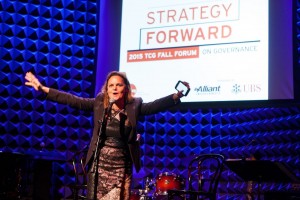“I am bound to everyone on this planet by a trail of six people. It’s a profound thought…. How every person is a new door, opening up into other worlds. Six degrees of separation between me and everyone else on this planet.”
—from Six Degrees of Separation, by John Guare
Those degrees have diminished since 1990, when John Guare wrote his influential play Six Degrees of Separation. According to a 2011 study of Facebook from the University of Milan, any two individuals in the world are now separated by an average of only 4.74 acquaintances, and those of us that share a country, by only three. These days, you don’t need to have worked with Kevin Bacon to link yourself to almost anyone.
However, diminishing the degrees of separation is not the same thing as strengthening our bonds of connection. Some research indicates that our hyper-connectivity online may actually feed the polarization of our culture by linking us to those with whom we already agree.

Compare that to the experience of many theatre people: teaching playwriting to third graders in a public school in the morning; sharing their vision with a CEO over lunch; connecting with community partners at a homeless shelter in the afternoon; and then bringing them all together in the theatre at night. At our Audience (R)Evolution Learning Convening in Philadelphia this February, I was inspired by the many ways theatres were diminishing the degrees of separation within their communities:
- Mixed Blood Theatre Company shared how its Radical Hospitality program offers all tickets at no cost to create a truly inclusive audience;
- The Theater Offensive talked about OUT in Your Neighborhood, its collaboration with local businesses and organizations to connect with LGBT people of color;
- Ping Chong + Company led a workshop of its Undesirable Elements program, which uses interview-based and devised theatre techniques to create theatre with and for people living between cultures.
The Learning Convening emerged from our strategic focus on audience engagement and community development, but as those examples demonstrate, our strategic focus on diversity and inclusion was also powerfully present. These elements of our strategic plan connect to our new vision statement, and its central call for:
A better world for theatre.
A better world because of theatre.
Increasingly, I believe the key to achieving both halves of this vision lies in theatre’s power to transform degrees of separation into degrees of connection. This begins internally, by confronting our own biases and unconscious assumptions, but it expands in concentric circles to transform:
- Our institutions—at both the Learning Convening and our Fall Forum on Governance: Leading the Charge! this past fall, an urgent need was sounded for theatres to evolve past our silos and internal degrees of separation. A vision for change must begin at the leadership level and be widely shared throughout the organization in order to succeed.
- Our stages—whether it was a library lending out tickets to see shows at Long Wharf Theatre in Connecticut, or Out of Hand Theater of Georgia’s Guerilla Haiku taking crowd-sourced creativity to the streets; theatres are breaking down real and perceived barriers to their work.
- Our communities—I recently met with the Performance Network Theatre of Michigan and learned how it connects audiences with agencies addressing the societal problems raised by its plays. Another example: inspired by the themes of its production of David Lindsay-Abaire’s Good People, Arena Stage in Washington, D.C., held a job fair.
While these actions are local, taken collectively, they have the power to transform our polarized country and world. The need for collective national action is especially apt in the month of April. On April 8 and 9, hundreds of arts practitioners will descend upon Washington, D.C., for Arts Advocacy Day, raising our collective voice on the importance of arts funding, the power of arts education and much more. The power of collective action also drives our Member Theatres’ participation in field-wide research like the Fiscal Survey and Theatre Facts; and our Blue Star Theatres program, connecting military families, theatres and their communities.
Our resident theatre movement has built a remarkable infrastructure in 50-plus years. We are blessed with an ecology that grows ever more diverse, across size, aesthetics, geography, age, organizational structure, race, class, gender and all the intersections of difference. With more than ten thousand theatre practitioners, and more than 30 million people attending not-for-profit professional theatre annually, we have a powerful—yet often underutilized—capacity to change the world, together.
So let us transform the degrees of separation into degrees of connection, and create a better world for and because of theatre.

